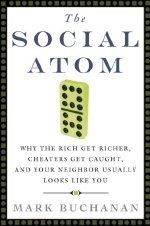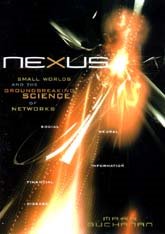An anonymous commenter in the New York Times, responding to my previous columns, suggested that my title “Our Lives as Atoms” (this is the title under which these posts appear in the NYT) is "more than a little puzzling,” and wondered “Where will all this lead us?” I’ve written about the amplified polarization of opinion in the political blogs, and about the abuse at Abu Ghraib prison, which had a disturbingly eerie resemblance to famous experiments at Stanford University 36 years ago. What does any of this have to do with atoms? Fair question. I’d like to start my answer by telling you about a strange phenomenon in Spitsbergen.
Spitsbergen is a Norwegian island in the Svalbard archipelago. It has spectacular mountains, abundant glaciers and desolate tundra, where stones are littered over a flat and mostly featureless terrain. In places on this tundra, the stones are arranged in a remarkable way; they lie not in a chaotic, haphazard jumble but in an ordered array of hauntingly beautiful, nearly perfect circular piles. You really have to look at a photo to believe it.
Where do these stone circles come from? Some might suspect the activity of intelligent agents, the local people, perhaps. But in fact, these circular piles arise all on their own by a natural process, with no human intervention. As geophysicists Mark Kessler and Brad Werner first explained a few years ago, forces associated with freezing and thawing push the stones into stretched-out piles, and then curve the long piles around (at least sometimes) to form complete rings.
Our human intuition is ill-prepared to understand such “spontaneous order” in the physical world. Suppose you put some sand in a shallow box with a lid and shake it up and down. Will anything interesting happen? Most people think not. But when physicist Harry Swinney and colleagues at the University of Texas at Austin did this experiment a few years ago – O.K., they used millions of tiny ball bearings rather than sand – they found something very surprising. When the frequency of shaking speeds up and exceeds a certain limit, beautiful wave-like patterns form in the box.
Such spontaneous order is caused by feedback. A little pattern, even if it arises quite by accident, sets up forces that reinforce the pattern. A little clumping of stones on the tundra triggers physical reactions that lead to more clumping, and eventually to stone piles.
This still says nothing about what our lives have to do with atoms. But bear with me a tiny bit further.
The physical world contains lots of kinds of stuff – liquids and solids, metals that conduct electricity and rubber that doesn’t, semiconductors and superconductors, liquid crystals and magnets. These things are made of different kinds of atoms, but that’s not the only reason why they’re different from one another. One of the most important lessons of modern physics is that the way things are organized sometimes matters more than what they are made of. The same carbon atoms that make soft, dull graphite also make sparkling and super-hard diamond. Organization matters.
Which returns me to the mysterious title, “Our Lives as Atoms.” It may be a crude analogy, but people are akin to “atoms” in that we are the elementary building blocks of the social world. Although we tend to think of ourselves as individuals making up our own minds, we’re obviously influenced by what others around us do. Social patterns routinely emerge that have little to do with the character of individual people.
In June 2000, on the afternoon of the opening of the London Millenium Bridge, the first pedestrian bridge built across the Thames River in central London for more than a century, a policemen noticed the bridge begin to sway from side to side. Authorities quickly herded the people off and shut the bridge. What had caused the problem? The best explanation is that people’s feet, simply by walking, had set up a weak vibration in the bridge, a gentle swaying, which created feedback.
To keep their balance, people found it easier to adjust their gait and walk in time with the sway. But this amplified the motion. The more the bridge swayed, the more people adjusted their gait, making the bridge sway even more, until it was swinging several inches to either side. It was spontaneous order indeed, and of a rather dangerous kind.
This is a nice metaphor for how individual actions work together to create larger social forces. We don’t ordinarily think this way, I suspect, because our inner voice usually explains things in terms of narratives that refer to peoples intentions, thought processes and so on.
But it would be a very strange world indeed if the basic logic of spontaneous order didn’t affect us – possibly at many levels – in the way we think, the opinions we have, the clothes we wear, our political beliefs, what we do for a living and so on. In my first two columns, I looked at how individual psychology feeds into the mechanisms of the Web to create and amplify polarized opinions, and how the situation at Abu Ghraib prison, like situations in thousands of other prisons worldwide, set up the preconditions that made abuse more likely, perhaps even predictable.
I hope that clears up the connection to atoms, for Anonymous or anyone else. Maybe this column should have been the first one, but then, that’s the way the human mind works – trial and error. And ideally, correction.
Friday, May 11, 2007
How order creates itself
Subscribe to:
Post Comments (Atom)




5 comments:
No Prescription medication Pharmacy. Get Cheap Medication online. Buy Pills Central.
[url=http://buypillscentral.com/buy-generic-brand-levitra-online.html]Buy Best Viagra, Cialis, Levitra, Tamiflu[/url]. rx generic pills. Top quality medications pharmacy
As a replacement for multitudinous years Buy off Cialis Lower Dispensary has been recognizable surrounded by unequalled online apothecary suppliers and customers around Discount Viagra Pharmacy On-line the world.
At our department store you can regard numerous medication and of programme naturally such predominant order Cialis now one – Cheap Generic Cialis pharmacy.
Our polished support team of high practised pharmacists will help you buy Cialis Online, consulting on varied constitution questions.
Greetings - I should say, I am impressed with your website. I had no difficulty navigating through all the tabs and the info was very simple to access. I found what I needed in no time at all. Truly awesome. Erica - auto insurance california
Post a Comment